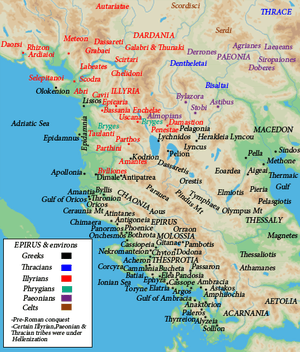Kastritsa
| Kastritsa Καστρίτσα | |
|---|---|
 Kastritsa | |
|
Location within the region | |
| Coordinates: 39°37.9′N 20°55.3′E / 39.6317°N 20.9217°ECoordinates: 39°37.9′N 20°55.3′E / 39.6317°N 20.9217°E | |
| Country | Greece |
| Administrative region | Epirus |
| Regional unit | Ioannina |
| Municipality | Ioannina |
| Municipal unit | Pamvotida |
| Population (2001)[1] | |
| • Rural | 668 |
| Time zone | EET (UTC+2) |
| • Summer (DST) | EEST (UTC+3) |
| Vehicle registration | ΙΝ |
Kastritsa (Greek: Καστρίτσα, before 1927: Μπαρκμάδι - Barkmadi[2]) is a village in the municipal unit of Pamvotida, Ioannina regional unit in Greece. In 2001 its population was 668. It is situated on a hillside near the southern shore of Lake Ioannina. It is situated 2 km southwest of Vasiliki, 3 km east of Katsikas and 7 km southeast of Ioannina. The Egnatia Odos motorway (Alexandroupoli - Thessaloniki - Ioannina - Igoumenitsa) passes south of the village.
Name
Until 1927 the village was named Barkoumadi or Barkmadi (Greek: Μπαρκουμάδι or Μπαρκμάδι), after the Albanian words bark and madh literally meaning big belly and metaphorically "the good eater".[3] In 1927 it was renamed to Kastritsa after the ruins of a castle located near the village.[2]
Population
| Year | Population |
|---|---|
| 1981 | 754 |
| 1991 | 747 |
| 2001 | 668 |
Archaeology

Artifacts found in the vicinity are believed to demonstrate a human presence in the village from the Neolithic age until historic times.
The site of ancient Tekmon is recognized as being at Kastritsa[4] or that of Eurymenai (Epirus).
West of the village is the height Kastritsa which is rich in artifacts. At the elevation, the following have been found:
On the west bank, there is a cave with evidence of occupation dating back to around 20,000 and 10,000 years ago, the new period of the Paleolithic age in Greece. The cave was reported by English archeologists in 1967. In the north side, another cave with paintings from the late Neolithic age. On the foot of the location, it has a tomb of the Late Helladic period.
East of the village a settlement has been found in 1948-49, which was reported by S. Dakaris in 1951-52. Artifacts (tombs, ceramic) showed it was settled from the Neolithic age until the historic years. North of the hill features the ancient Acropolis Tekmon (Τέκμον) which used the ancient art with a perimeter of about 3,000 m with 5 entrances, the central entrance is in the northeastern side of the hill.
See also
References
- ↑ De Facto Population of Greece Population and Housing Census of March 18th, 2001 (PDF 39 MB). National Statistical Service of Greece. 2003.
- ↑ 2.0 2.1 Name changes of settlements in Greece
- ↑ "Kastritsa". Pamvotida Municipality. Archived from the original on 2011-07-21. Retrieved 20 July 2010.
- ↑ An Inventory of Archaic and Classical Poleis: An Investigation Conducted by The Copenhagen Polis Centre for the Danish National Research Foundation by Mogens Herman Hansen, 2005, page 349
External links
| ||||||||||||||||||||||||||